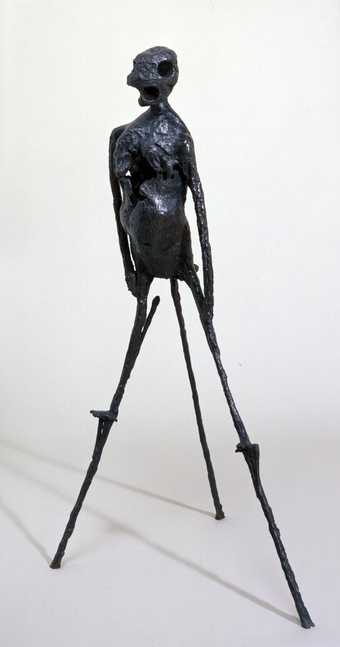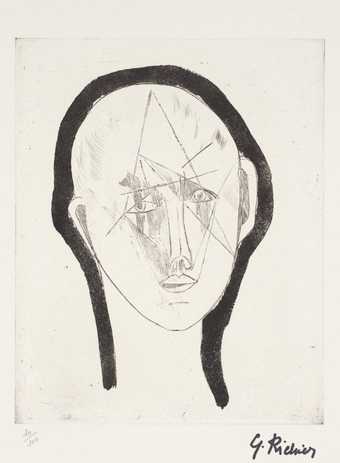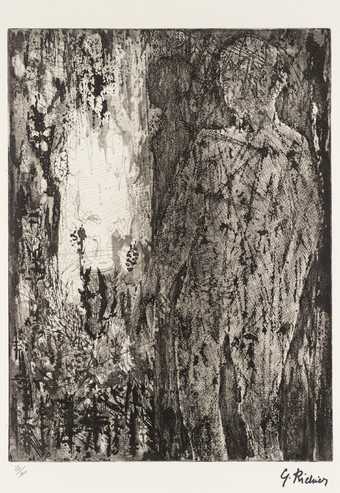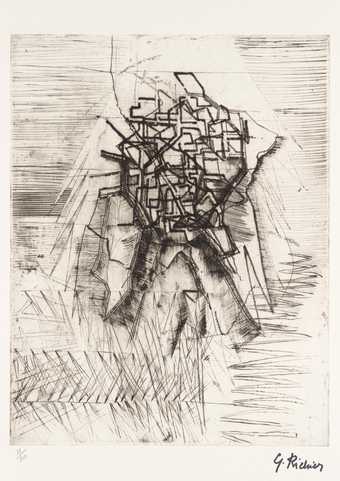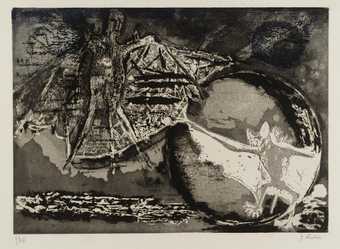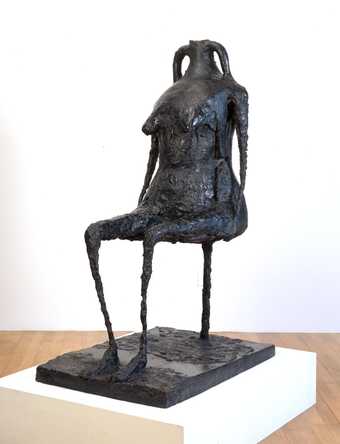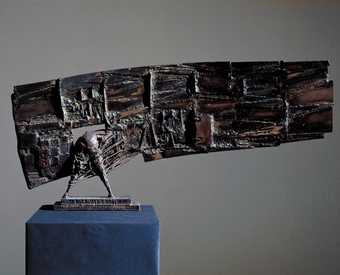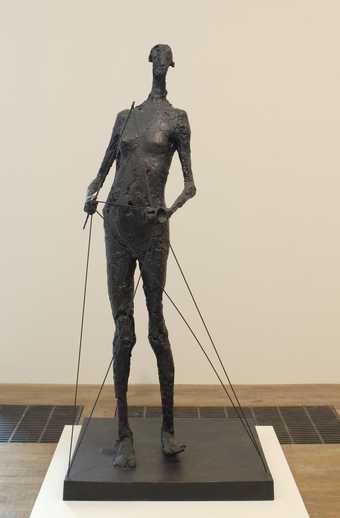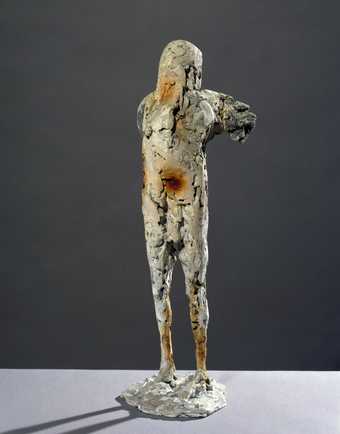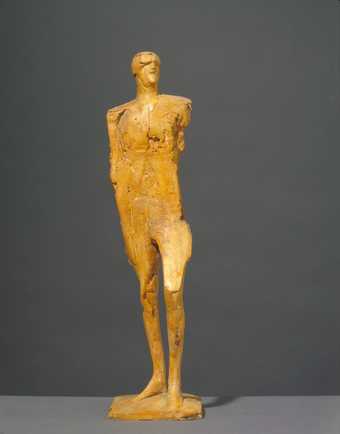On loan
Musée Fabre (Montpellier, France): Germaine Richier
- Artist
- Germaine Richier 1902–1959
- Original title
- L'Echiquier, grand, plâtre original peit
- Medium
- Plaster and metal
- Dimensions
- Collection
- Tate
- Acquisition
- Presented by the artist's estate 2000
- Reference
- T07616
Summary
This is a group of five sculpted and painted plaster figures mounted on free-standing plaster supports. The figures are semi-abstracted, combining human and animal characteristics. They are based on a smaller version, L’Echiquier, petit (Chessboard, Small Version) 1955 (reproduced Barbero, pp.102–3), that comprises five figures modelled in clay and plastiline standing on a board made of a piece of scrap iron and worked over in clay, all finally cast in bronze. In this work Richier’s intention was to represent the theme of the game of chess and its pieces, which for her was the possibility of moving the figures around the board (Barbero, p.102). The large version was modelled in clay by the sculptural technician Robert Haligon soon after Richier returned to Paris from southern France in April 1959, before being cast in plaster and painted by the artist. In the larger size, the board of the original was completely dispensed with and the stumpy supports of the small figures were translated into much taller individual bases of varying heights, conferring an increased sense of the potential for mobility.
Richier’s Chessboard comprises the five principal pieces in a game of chess: the King, the Queen, the Bishop, the Knight and the Castle. Each is a roughly humanoid figure, standing on two legs, apart from the Castle, which has three and is the most abstracted of the figures, its body an elongated conglomeration of horizontal and vertical surfaces that extend upwards in four stick-like protruberances with bulbous ends. The head of the King recalls a symmetrically branching plant form; the callipers he holds in his left hand were essential sculpting tools for Richier, who used them in transferring measurements from her models to the clay she normally worked on. His protruding belly sports an enlarged belly button which in the case of the Queen has become a hole that pierces the width of her body. She has realistic human buttocks, but the head of an abstracted cow, while her arms are extended into verticals, one of which reaches high above her head, constituting the tallest element of the group (over 2 metres). The Knight, appropriately, has a horse’s head; his arms disappear into a perforated insectoid thorax mounted on stick-like legs without feet. Finally the Bishop – known as the Fool (le Fou) in French – sports a stylised jester’s cap above a face that, though distorted, is recognisably human. His body, on human legs, is an egg-like form with a short protruding tail.
After being modelled in clay and cast in plaster, the majority of Richier’s sculptures are cast in dark patinated bronze, resulting in the dark grey shades of works like Water 1953–4 (T00075) and Diabolo 1950 (T07004), or the polished natural bronze that resembles gold of The Bat 1946 (L02176). In 1959 the practice of applying paint to her sculptures was a new one for Richier, although she had been moving towards it in the preceding years. In 1952, she invited the artists Maria Vieira da Silva (1908–92) and Hans Hartung (1904–89) to paint the backdrops on two of her sculptures – La Ville and La Toupie respectively (reproduced Germaine Richier, pp.134–5). She herself began applying painted colour to her sculptures in 1956, when she painted on the polished natural bronze surface of some of her Personnages. Later that year she began experimenting with the possibilities for enamelling some of her bronzes. During a holiday at Juan-les-Pins in the summer of 1958 she briefly took up painting on canvas and commented during that year: ‘With this business of colour, I may be wrong or I may be right, I don’t know. Anyway, what I do know for sure is that it pleases me. Sculpture is serious. Colour is gay. I want my statues to be gay, alive. Colour on a structure is usually distracting. But after all, why not?’ (Quoted in Barbero, p.116.) Between April and June 1959 she painted seven bronze sculptures and the five plaster figures that make up T07616. When they were first exhibited at the Musée Grimaldi-Château d’Antibes in July–September that year, their colours were brilliant and distinctive, characterised by the combination of vertical and horizontal line (combined with circular and triangular forms) that were for Richier the essentials of sculptural composition and structure, and which she often drew onto her subjects as part of the process of mapping form from the original onto her clay.
After Richier’s death, two weeks into her exhibition at the Musée Grimaldi-Château d’Antibes, moulds were created from the plaster figures that make up Chessboard, Large Version for the purpose of producing an edition in bronze (reproduced Barbero, p.117). In the process of this, the figures were coated with a shellac varnish to seal them, contributing a yellowish shiny surface and a dulling of the paint colours, resulting in the appearance they have today.
The rough and pitted surfaces and frequently emaciated limbs of many of Richier’s sculptures recall the aesthetic of such sculptures by her friend Alberto Giacometti (1901–66) as Man Pointing 1947 (N05939) and Standing Woman 1948–9 (T00780). However her exploration of hybrid human-animal or -insect and anthropomorphic forms has its precedent in the imagery created in the 1940s by such surrealists as Max Ernst (1891–1976) and Wifredo Lam (1902–82). Ernst’s sculpture The King Playing with the Queen 1944 (Museum of Modern Art, New York) presents a male upper torso with an abstracted square-shaped horned head fixed to a section of chessboard, on which the Queen, Bishop, Knight and Castle face three pawns, over which he presides. While Ernst was concerned with a personal mythology, woven from a variety of cultures combined with moments of mystical and emotional intensity in his own life, Lam painted groups of hybrid figures, such as The Jungle 1943 (Museum of Modern Art, New York), as a way of reconnecting with his Afro-Cuban roots. In a similar way, Richier appears to have been drawn to human-animal-vegetable hybridity by a nostalgia for her childhood in rural southern France and its connection to archaic myths and fables. She explained:
Although unpremeditated, my ‘subjects’ belong to the world of metamorphosis … to this animal that is more than animal, within or after the form… the fantastic creatures of an age that we are incapable of recognizing, but which is ours, since the world of forms intervenes unceasingly during our research and observation. Everything depends on the drama perceived. In fact, it is discovered along the way, from the elements. Exact science, human science – the value of sculpture depends on this dual relationship, between observation and creation; between truth and imagination … the being seized takes on value from its organic density, from the play and interaction of the elements. If one were to speak of sculpture’s superlative function, one would say that it rediscovers the meaning of the world and of the hybrid.
(Quoted in Andrew Carnduff Ritchie (ed.) The New Decade: 22 European Painters and Sculptors, exhibition catalogue, Museum of Modern Art, New York 1955, pp.35–7.)
Chess as a subject for art was famously introduced by Marcel Duchamp (1887–1968), for whom the logic of the game was a central attraction, generating the production of several designs for chess sets as well as the claimed the abdication of artmaking in preference for playing the game. Ernst’s sculpture The King Playing with the Queen was created for an exhibition conceived with Duchamp and the surrealist dealer Julien Levy in 1944–5 on the theme of the chess set. While it is normally associated with analytical rationality, Richier subverts this in her version of the chessboard in which magic and mystery predominate. She said: ‘for me, sculpture is something intimate … It’s above all that which one has inside one.’ (Quoted in Barbero, p.56.)
Further reading:
Germaine Richier: Rétrospective, exhibition catalogue, Fondation Maeght, Paris 1996, reproduced pp.184–5.
Germaine Richier, exhibition catalogue, Akademie der Künste, Berlin 1997, pp.138–51.
Luca Massimo Barbero, Germaine Richier, exhibition catalogue, Peggy Guggenheim Collection, Venice 2006, pp.116–7.
Elizabeth Manchester
November 2009
Does this text contain inaccurate information or language that you feel we should improve or change? We would like to hear from you.
Display caption
These five figures represent the core pieces in a game of chess: the King, Queen, Knight, Castle and Bishop. The game stages a war in which the aim is to attack and capture the opponent's pieces. Richier’s figures are unlike the elegant designs of traditional chessmen. Instead they are grotesque hybrid figures, part human, part animal. Richier used their distorted forms to reflect the anxieties and despair of Europe after the Second World War. ‘It seems to me that in violent works there is just as much sensibility as in poetic ones’, she said. ‘There can be just as much wisdom in violence as in gentleness’.
Gallery label, June 2020
Does this text contain inaccurate information or language that you feel we should improve or change? We would like to hear from you.
Explore
- abstraction(8,615)
-
- from recognisable sources(3,634)
-
- figure(2,270)
- emotions and human qualities(5,345)
-
- horror(180)
- sports and games(230)
-
- chess piece(12)
You might like
-
Germaine Richier Shepherd of the Landes
1951, cast 1996 -
Germaine Richier Personage
1948–9, published 1961 -
Germaine Richier Self-Portrait
1948–9, published 1961 -
Germaine Richier Insects
1948–9, published 1961 -
Germaine Richier Portrait
1948–51, published 1961 -
Germaine Richier Untitled
1948–51, published 1961 -
Germaine Richier The Hurricane
1955, published 1961 -
Germaine Richier Untitled
1954–6, published 1961 -
Germaine Richier Bat
1948–51, published 1955 -
Germaine Richier Water
1953–4 -
César (César Baldaccini) The Man of Saint-Denis
1958 -
Hubert Dalwood Large Object
1959 -
Germaine Richier Diabolo
1950, cast 1994 -
Dame Elisabeth Frink Bird Man
c.1966 -
Dame Elisabeth Frink Small Male Figure with Goggles
c.1968


